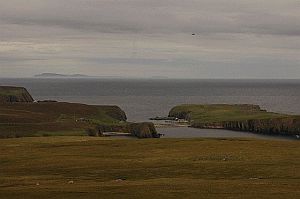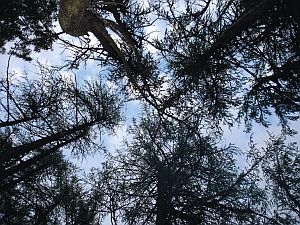
| 18 juin 2005 - Caledonian Canal / Loch Lochy - 56°55'N 4°59'W | |||||||||||||||||||||||||||||||||||||||||||||||||||
|
Mais l'endroit est magique et l'on ressent l'éloignement du monde. Après une courte nuit, nous mettons pied à terre pour découvrir l'île qui fait à peine 5 km de long. De tous les cotés d'impressionnantes falaises tombent à pic dans la mer et laissent imaginer la violence des vagues dans ce passage à l'ouvert de l'Atlantique et de la Mer du Nord, exposé aux tempêtes, courants et marées.
Ces mêmes falaises donnent lieu à des nichoirs priviliégiés des oiseaux de mer: pétrels, cormorans, macareux et guillemots - tous peu farouches et laissant s'approcher et observer sans peur. Nous sommes gâtées par des conditions météorologiques idéales: le soleil est 'presque' au rendez-vous, la vue est dégagée et nous permet d'apercevoir à la fois les hautes falaises des Shetland au nord et les courbes arrondies et très basses sur l'eau des Orkney à 40 milles au sud-ouest. En fin de journée, après une longe randonnée à travers champs et bruyères, nous larguons les amarres, cap sur les Orkney que nous entendons atteindre au petit matin. Une nuit de navigation sans histoires nous amène dans l'archipel, réputé pour ses forts courants marins qui traversent les étroits passages entre les îles. Nous en profitons pour tirer des bords à la voile en nous aidant du courant.
Le soir, nous larguons à nouveau les amarres pour une dernière étape vers Inverness où nous débarquerons Vincent, au grand regret de l'équipage car de concernt avec Salvatore, la cuisine du bord atteint à nouveau des sommets gastronomiques... qui dit qu'on mage mal à bord?? Il fait de plus en plus chaud et par moments nous avons encore du mal à nous adapter à ces nouvvelles conditions. il s'agit à présent de se protéger de la chaleur (20°) mais aussi du soleil et bientôt des moucherons qui ne tarderont pas de se manifester. Inverness est aussi l'extrémité nord-est du canal calédonien, voie naviguable mythique dont la construction a été entrepris voici 2 siècles. Le canal utilise un enchaînement de longs lacs (Loch Ness, Loch Oich, loch Lochy) et permet aux embarquations de plaisance et bateaux de pêche de relier en toute tranquilité la Mer du Nord avec l'Atlantique en évitant un passage agité et éprouvant par le nord de l'Écosse. C'est aussi un parcours touristique qui permet de découvrir l'intérieur de l'Écosse, ses forêts, châteaux, brouillards, marécages et étonnantes forêts de rhodendendron, en pleine fleur en cette fin juin. Une fois acquitté la taxe de passage prohibitive, nous enchaînons les écluses. C'est un style de navigation bien différent de ce que connaît Imram, notre voilier, plus habitué aux grans espaces sauvages et imprévisibles. Les tronçons naviguables sont courts et les arrêts et attentes nombreuses. Tout est réglé sur l'horaire d'ouverture des écluses et des ponts levants - impossible d'improviser un rhythme comme en mer. Si par moments, nous ne pouvons nous empêcher de penser que nous sommes tombés dans un piège à touristes, nous réussissons tout de même à improviser nos visites et excursions terrestres. Amarré au petit ponton privé réservé aux promenades en bateau pendant la journée, nous profitons du crépuscule pour la visite du château d'Urquhart, en ruine. Les heures de visite sont terminées depuis longtemps et nous foulons les ruines en imaginant la vie du château il y à 5 ou 10 siècles. Surprise, nous ne sommes pas seul à apprécier ce moment du début de la nuit. Un petit groupe de filles décorées de fleurs colorées se préparent pour une nuitée druidique en dansant autour d'un feu.
L'endroit est enchanté: avec l'annexe gonflable nous traversons un épais rideau de végétation avant de toucher la terre ferme, à l'abri de tout regard. Sans tarder, nous allumons un feu qui nous enrobe bientôt dans sa fumée aux parfums de résine brulée, idéal pour griller les quelques côtelettes d'agneau succulents.

After a short night we set off to discover the island. Despite its comparative small dimensions, 5km in the long side, it has lots to offer. First, its scenery, from all sides, sheer rock faces fall down to the sea and leave little to the imagination for what concerns the violence of the North Sea swell and tides.
At a closer look, these rock faces bear much more than the scars of erosion: they are alive with tens of thousands of petrels, cormorans, puffins and guillemots. They are not easily scared and they let us crawl close to their quarters, to share their view from the cliffs. And what a view, in the clear air we can see, at once, the sheer and high coast of the Shetland and the lower, rounder, shapes of the Orkney, our next target after a long day of waking in the fields, over all the summits of Fair Isle, in company of a few cows and many rabbits, in addition to the ubiquitous muttons and lamb, which we fail to befriend. Maybe calling a small lamb "dinner" is not the best way to have him follow you onboard... Before we leave, a fair deal is stoke with some local fishermen, clearly impressed by our Shetland courtesy flag. We barter some freshly-caught fish for some Swiss chocolate.
A strange encounter on the way... a red light over a white light under a flashing orange light... no light book is very helpful and, after a while, a submarine of HM navy comes to say hallo to Imram, she sails for a while to our starbord side, then we cross paths and we are escorted for a while to the port side, before she leaves for the open sea... no other remarkable facts before we moor in Inverness. Vincent leaves us, and instead of two cooks for five crew members, we are now left with only Salvatore to cater for four of us... By the way, who told that on a sailboat you've to eat badly? In the last weeks, on-board freshly baked bread was definitly superior to that on offer in some of the villages we crossed, lasagne and pasta gratin were hearthy and filling, while smoked sausages with vegetables, fish fillets with lemon and herbs, chili con carne, pizzas and -of course- scottish breakfast all contributed to our varied diet. Not to be forgotten are a chocolate cake and the tortillas which, regularly, celebrate the end of longer sections at sea. Unexpectedly for a late spring in Scotland, the weather is warmer and warmer, and, after the winter of Tromso and the spring of the south of Norway, we are fastly moving into Summer, with the thermometer in the 20's, the need for sunscreen and, alas, mosquito repellent for the fleece which inhabit the still waters of some boggy sections of the scottish waterways. Indeed, the next section of our trip will be quite incongrous for a vessel as our Imram: the quiet waters of the Caledonian Canal which, from Inverness, traverses all of Scotland till the Western coast. A link from the North Sea to the Atlantic, built a century and a half ago to spare vessels the passage around the bleak and dangerous North coast of Scotland. After the white hues of Greenland and Spitzberg, the gray colours of the Barents sea and the gray-blue colours of the North Sea, an intoxicating green is all around Imram. Its hull sees freshwater again, not the blue waters of Lake Geneva, but the dark brown waters of Loch Ness, Oich and Lochy. Between these three lakes, the channel cuts between typical countryside with cottages, herd of muttons, country tracks and wonderful forests, ruined castles, mystical mist, eerie swamps and almost incongrous shining liliac and rhododhendrum flowers. We do feel slightly ripped off by the otrageous passage fee, but a lock after the other, we move on through this new rythm of locks and swinging bridges, where the cars are stopped to let us pass. A office-hour working schedule is imposed to clear these passage and climb to the middle of Scotland first and descend to the sea again later. We cannot follow our 24-hours rythm...and we are poised to find a way to escape the tourist-trap atmosphere. We go down a section of the Loch Ness with our colorful spinnaker,
reaching the Urquahart castle at sunset. The place, now empty, is
full of atmosphere and, squatting the private jetty of the tourist
tours, we go ashore and have the ruins all for us. Back to the boat,
we see the vessels of the Deepscan Project lowering vaguely scientific-looking
materials in the lake, looking for the monster, while Peter and
Rob go for a swim: did they trigger some alarm in the network of
sensors supposed to trap Nessie?
Précédent | Index 2005 | Suite/next The
Imram Voyage 2005 - Integral 12.50 - ACAPELA, 2004 |











